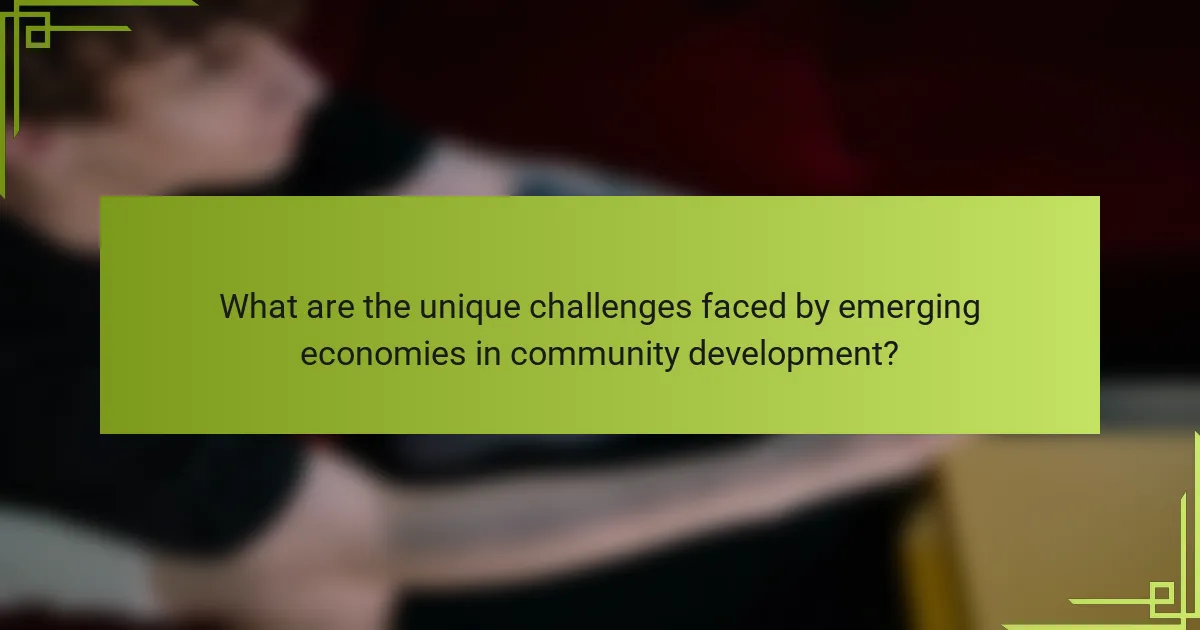Community development in modern empires faces challenges such as resource constraints and political instability. Key principles focus on inclusivity, sustainability, and empowerment. Effective resource strategies are crucial for economic growth and innovation. Technological advancements enhance community engagement and resource management, driving resilience and prosperity.

What are the key principles of community development in modern empires?
Key principles of community development in modern empires focus on inclusivity, sustainability, and empowerment. These principles ensure that communities thrive through active participation and resource management. Collaboration between stakeholders fosters social cohesion and addresses local needs effectively. Additionally, leveraging technology enhances communication and resource allocation, leading to improved community resilience.
How do cultural values influence community engagement strategies?
Cultural values significantly shape community engagement strategies by influencing priorities and methods. Understanding local beliefs fosters trust and collaboration. For instance, communities valuing collectivism may prefer participatory approaches, while those emphasizing individualism might favor direct communication. Effective strategies align with these cultural nuances, enhancing participation and resource allocation.
What role does governance play in community development initiatives?
Governance plays a crucial role in community development initiatives by providing structure and accountability. Effective governance ensures that resources are allocated efficiently, promoting sustainable growth. It fosters collaboration among stakeholders, enhancing community engagement and trust. Additionally, governance frameworks can adapt to local needs, addressing unique challenges and opportunities. This adaptability is a rare attribute that distinguishes successful initiatives from less effective ones.
Which methods are most effective for fostering local leadership?
Effective methods for fostering local leadership include community engagement, mentorship programs, and resource allocation. Community engagement builds trust and encourages participation, while mentorship provides guidance and support. Resource allocation ensures leaders have the tools necessary for success. These strategies enhance leadership capacity and promote sustainable development.

How do resource strategies impact economic growth in modern empires?
Resource strategies significantly influence economic growth in modern empires by optimizing resource allocation and enhancing productivity. Effective management of natural and human resources leads to sustainable development and increased wealth. For instance, empires that prioritize technological advancements and education often experience accelerated innovation and economic diversification. Furthermore, strategic trade partnerships can enhance market access, fostering competitive advantages. In contrast, mismanagement or overexploitation of resources can lead to economic decline and social unrest. Thus, the alignment of resource strategies with economic goals is crucial for the prosperity of modern empires.
What are the most common resource allocation models used?
The most common resource allocation models used in “Empires: Dawn of the Modern World” include centralized, decentralized, and hybrid models. Centralized models concentrate decision-making power, allowing for streamlined resource distribution. Decentralized models empower local leaders to allocate resources based on immediate needs, fostering community engagement. Hybrid models combine elements of both, balancing efficiency with local responsiveness. Each model influences community development strategies and impacts gameplay dynamics significantly.
How do historical resource management practices inform current strategies?
Historical resource management practices significantly shape current strategies by providing lessons in sustainability and community engagement. Empires in “Dawn of the Modern World” employed diverse resource strategies that focused on efficient allocation and local empowerment.
For example, the Roman Empire optimized agricultural practices through infrastructure, such as aqueducts, enhancing food security. This principle of integrating resource management with community development informs modern strategies aimed at resilience and self-sufficiency.
Additionally, the unique attribute of adapting to local conditions, seen in various empires, emphasizes the importance of context in today’s resource strategies. This adaptability is crucial for addressing current global challenges, such as climate change and population growth.
Lastly, rare attributes, like the use of trade networks to distribute resources, illustrate the value of collaboration in contemporary resource management. By learning from these historical practices, current strategies can foster stronger communities and ensure sustainable resource use.
What challenges do empires face in sustainable resource management?
Empires face significant challenges in sustainable resource management due to overexploitation, political instability, and environmental degradation. Overexploitation leads to resource depletion, undermining long-term sustainability. Political instability disrupts governance and resource allocation, complicating management efforts. Environmental degradation results from industrialization, threatening ecosystems and biodiversity. Effective strategies must balance resource utilization with ecological preservation to ensure future stability.

Which technological advancements are shaping community development?
Technological advancements are significantly influencing community development by enhancing resource management and engagement strategies. Innovations such as smart city technologies, data analytics, and renewable energy systems are reshaping how communities operate.
Smart city technologies facilitate efficient infrastructure management, improving public services and resource allocation. Data analytics empowers community leaders to make informed decisions based on real-time information, enhancing responsiveness to residents’ needs. Renewable energy systems promote sustainability, reducing reliance on fossil fuels and fostering environmental stewardship.
These advancements create opportunities for collaboration and innovation, driving economic growth and improving quality of life. As communities adopt these technologies, they can better address challenges and leverage resources for development.
How does digital infrastructure enhance resource distribution?
Digital infrastructure significantly enhances resource distribution by improving accessibility and efficiency. It enables real-time data sharing, allowing communities to respond swiftly to resource needs. This infrastructure supports better planning and coordination, optimizing supply chains and reducing waste. As a result, communities can allocate resources more effectively, fostering sustainable development and resilience.
What role does data analytics play in community needs assessment?
Data analytics is crucial for identifying community needs and guiding resource strategies. It enables data-driven decision-making by providing insights into demographics, preferences, and challenges within the community. This information helps in prioritizing initiatives and allocating resources effectively. By analyzing trends and patterns, stakeholders can tailor development strategies to meet specific community requirements, enhancing overall engagement and satisfaction.

What are the unique challenges faced by emerging economies in community development?
Emerging economies face unique challenges in community development, including limited resources, inadequate infrastructure, and political instability. These factors hinder effective planning and implementation of development initiatives.
Resource constraints often lead to competition for funding, making it difficult to prioritize community needs. Inadequate infrastructure, such as poor transportation and communication networks, limits access to essential services, impacting overall community well-being. Political instability can disrupt development efforts, creating an uncertain environment for investment and collaboration.
Additionally, cultural diversity presents challenges in aligning community development goals with local values and practices. Engaging stakeholders effectively is crucial for fostering cooperation and ensuring sustainable outcomes.
How do geopolitical factors influence resource strategies in different regions?
Geopolitical factors significantly shape resource strategies across regions by influencing access, control, and allocation. Regions rich in natural resources often experience power struggles, impacting their development and community dynamics. For instance, in the Middle East, oil wealth drives both economic strategies and geopolitical alliances. In contrast, resource-poor regions may prioritize sustainable practices to enhance resilience. Political stability, trade agreements, and international relations also dictate how resources are managed, affecting community development and social structures.
What are the effects of urbanization on community cohesion?
Urbanization can weaken community cohesion by disrupting social networks and increasing isolation. As cities expand, traditional community structures often diminish, leading to a decline in interpersonal relationships. The influx of diverse populations may create cultural tensions, further fragmenting social ties. Urban environments can also result in economic disparities, where wealth gaps foster division among residents. As a result, community engagement and collective identity may suffer, impacting overall social stability.

Which case studies exemplify successful community development initiatives?
Successful community development initiatives in “Empires: Dawn of the Modern World” include case studies that effectively utilized resource strategies. Notable examples demonstrate how strategic resource management led to sustainable growth and community engagement.
One case study highlights a community that improved agricultural practices, resulting in a 30% increase in crop yields. Another example involves a coalition that developed local trade networks, boosting economic resilience and reducing dependency on external resources.
Additionally, a project focused on education and skill development empowered individuals, leading to higher employment rates within the community. These initiatives showcase the importance of integrating local resources and community involvement for lasting impact.
What lessons can be learned from diverse global examples?
Diverse global examples teach valuable lessons in community development and resource strategies. Effective collaboration among stakeholders fosters sustainable growth. For instance, integrating local knowledge enhances resource management. Additionally, adaptive strategies that consider environmental changes lead to resilience. Lastly, prioritizing equity ensures inclusive development, benefiting all community members.
How do local partnerships enhance project outcomes?
Local partnerships significantly enhance project outcomes by fostering collaboration and resource sharing. They leverage community strengths and local knowledge, leading to more effective strategies and sustainable development. Engaging local stakeholders ensures that projects align with community needs, increasing buy-in and participation. Additionally, partnerships can provide access to unique resources and expertise, enhancing overall project effectiveness.

What are the best practices for implementing resource strategies in modern empires?
Effective resource strategies in modern empires focus on sustainability, community engagement, and technological innovation. Prioritizing renewable resources ensures long-term viability. Engaging communities fosters collaboration and enhances resource management. Leveraging technology optimizes resource allocation and improves efficiency. These practices lead to resilient and prosperous empires.
How can stakeholders collaborate for effective resource management?
Stakeholders can collaborate for effective resource management by establishing clear communication channels and shared goals. Collaborative frameworks enhance decision-making and optimize resource allocation. Regular meetings and feedback loops ensure alignment and adaptability. Utilizing technology for real-time data sharing fosters transparency and trust among stakeholders.
What common mistakes should be avoided in community development projects?
Common mistakes in community development projects include inadequate planning, neglecting community input, poor resource management, and lack of sustainability. These errors can hinder project success and community trust.
Inadequate planning often leads to unrealistic timelines and budgets, resulting in project failure. Neglecting community input can create resistance and disconnect, as local needs and insights are overlooked. Poor resource management, including misallocation of funds and personnel, can stall progress. Lastly, failing to incorporate sustainability measures can jeopardize long-term benefits, leaving communities vulnerable after project completion.
By recognizing and addressing these common pitfalls, community development projects can enhance their effectiveness and foster stronger community relationships.
How can ongoing evaluation improve community development efforts?
Ongoing evaluation enhances community development efforts by ensuring adaptive strategies and effective resource allocation. It allows stakeholders to identify strengths and weaknesses, enabling timely interventions. Regular assessments foster community engagement and accountability, leading to sustainable growth. This iterative process aligns resources with evolving community needs.